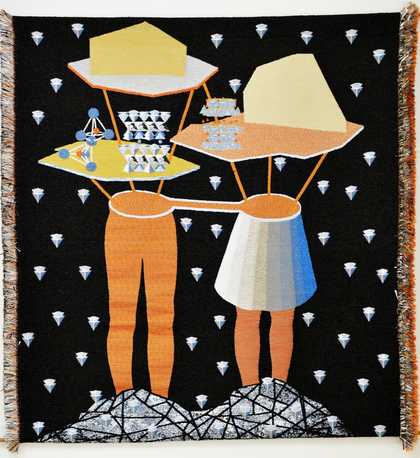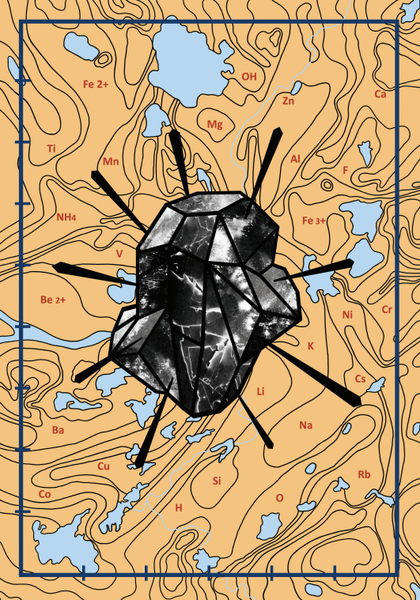
Drawing for the tapestry In Pursuit of Bling: The Discovery
Otobong Nkanga investigates the relationship between people and land through our consumption of Earth’s natural resources.
Drawing attention to minerals that hold qualities of shine and glimmer, she reveals their use in creating the ‘bling’ of everyday items such as cosmetics and technology. Connecting these desirable products to the social and environmental scars left by their creation, Nkanga makes evident the complex economic and political systems that shape our relationships with land.
Nkanga works with textile, drawing, photography, installation, video and performance. This exhibition brings together recent works, some of which are being shown publicly for the first time. She has also created new works responding to the landscape and histories of Cornwall. Displayed as an open installation, Nkanga invites visitors to discover and create connections between the constellations of works on show.
Otobong Nkanga was born in 1974 in Kano, Nigeria. She lives and works in Antwerp, Belgium
NEW WORKS
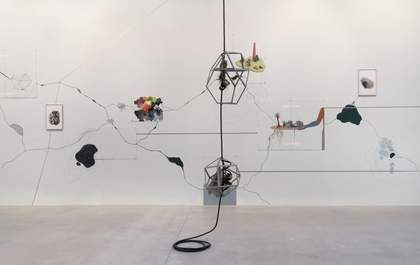
Photo: Tate Photography
Nkanga presents new works created for this exhibition, including a performance, sculptural and photographic installations, and a site-specific wall-painting created in the weeks prior to the exhibition opening.
Two steel posts display photographs of postindustrial landscapes, alongside images of minerals and models in museum collections. The photographs are printed onto processed metal sheets whose origins as ores reflect some of the mined landscapes and materials depicted in the photographs.
A series of hanging forms take their shapes from mathematical models of the molecular structures of minerals. Activated through a new performance at the outset of the exhibition, these forms also become hosts for objects and materials gathered by Nkanga during her time spent in and around St Ives.
COMPILED THOUGHTS LURKING AS I LOOK AT YOU
This two-part painting introduces visual and conceptual ideas that recur throughout Otobong Nkanga’s work. Considering the complex circumstances that shape relationships between people and land, Nkanga depicts bodies within various natural and built environments.
Across a background that resembles a map or aerial view, scenes of bodies and vegetation are connected to domestic and industrial buildings through a network of lines. Overlapping shapes suggest land boundaries, and bodies stand upon or emerge from the ground interacting with the plants, buildings and networks depicted. These fragmented scenes recall the interdependencies of people, communities and land resources.
IN PURSUIT OF BLING
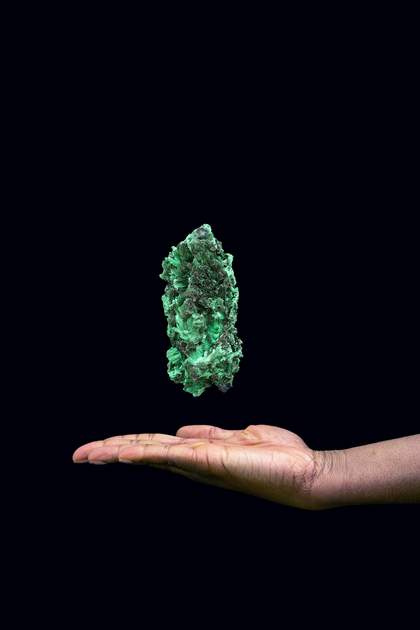
In Pursuit of Bling -Desire 2014
This series explores human consumption of the landscape, revealing the hidden transformations of the mineral mica into desirable products such as cosmetics. Nkanga contrasts the value we place on these commodities with the damage that their extraction causes to communities and the environment.
Two tapestries form the central element of the work. Themes of people, land and commodities are continued across a series of photographs. In one, Nkanga holds a piece of mica in front of her mouth, suggesting the interdependence between body, mineral and land:
Once I start thinking of minerals as something we swallow to make our body function, I also start to think of how our body comes to be composed of these minerals, and that when we gradually decay after death we become mineral components again. So, the gesture of swallowing a tablet or vitamin pill is as magical, or let’s say as supernatural, as we want, because we really are swallowing a stone. – Otobong Nkanga
THE WEIGHT OF SCARS
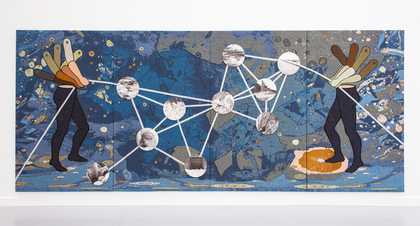
The Weight of Scars 2015
Technique/Materials, Woven Textile and photography/Yarns - viscose bast, mohair, polyester, bio cotton, linen, acrylic and inkjet print on 10 laser cut forex plates
Courtesy of the Artist, Lumen Travo, Amsterdam, In Situ / Fabienne Leclerc, Paris and Mendes Wood DM, São Paulo, Brussels, New York.
Photograph: M HKA
This large textile and photographic work incorporates recurring themes, of the mechanisation of the body in industrial labour and the interdependence of people and land. The work resonates with histories of Cornish mining, and the miners who took their skills and expertise across the world.
Two fragmented figures are connected to a network of ropes and pipelines that converge at photographs of abandoned mines. Their arms are shown in multiple positions suggesting the ‘push and pull’ of shifting relationships as land is consumed and changed. The ‘scars’ in the title suggest damaged and vulnerable bodies within a landscape devastated by the extraction of knowledge, people and resources.
Nkanga’s tapestries are influenced by textilemaking practices of West Africa, and her home country Belgium. Here, she weaves colourful yarns and metallic threads that give an impression of ‘glimmer’, reflecting the shimmering characteristics of minerals.
KOLANUT TALES

Kolanut Tales 2012
Photo: Tate Photography
This tapestry reflects on the harvesting and transportation of the kola nut and its cultural significance in Nigeria. Beneath the tree is depicted a cluster of kola nuts and pods, representing a West African story in which the gods leave behind a kola nut from which the first tree grew. Centered on a tree stripped of its leaves, its roots transform into tangles of barbed wire that form a protective frame around the image. Wrapped around the trunk are three protruding platforms, one holding an image of a kola tree and another supporting a photograph of kola nuts in transit.
TSUMEB FRAGMENTS

Tsumeb Fragments 2015
Photo: Tate Photography
This work is a constellation of photographs, video and raw materials gathered by Nkanga during a field trip to Namibia in 2015. She travelled along abandoned mining-railways to reach the town of Tsumeb, which sustained a nearby copper mine established when South West Africa was under German colonial control.
Remnants of the abandoned and excavated landscapes she discovered are presented in this work. Nkanga has modified raw materials, altering them beyond their natural state and echoing how resources are transformed for industrial and other purposes. In the video Remains of the Green Hill Nkanga made a spontaneous act of singing to the damaged the landscape to heal the scars caused by industrial extraction.
SOLID MANEUVERS
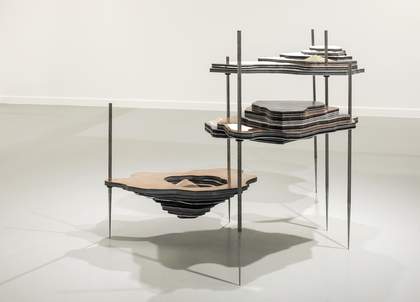
Solid Maneuvers 2015
Various metals, polyvinyl chloride, acrylic glass, tar, salt, make-up and vermiculite.
Courtesy of the artist
Installation view: M HKA, Antwerp, 2015
During her visit to Tsumeb, Namibia, Nkanga sought the Green Hill, a landmark once famed for its plentiful resources of rare minerals. In its place, she discovered an abandoned pit reaching deep into the ground. Nkanga considers the mine as a ‘negative monument’, an emptiedout landscape whose raw materials have been transported across the world for use in buildings, cosmetic products and technologies.
In Solid Maneuvers, three platforms represent geological layers with voids and absences, recalling the mined landscape of Cornwall. Nkanga combines raw materials such as sand with processed materials including make-up, salt and vermiculite.
What could a monument be? Is it the thing we build or the thing we have taken away from? A place of emptiness is the monument to remind us there is no possibility of getting back to what has been. – Otobong Nkanga
FROM WHERE I STAND
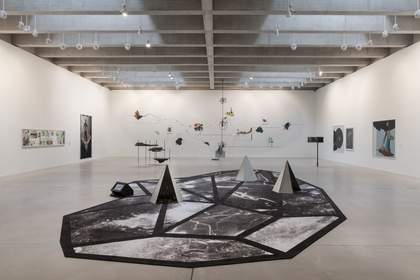
From Where I Stand 2019
Photo: Tate Photography
Installation view: Tate St Ives
From where you stand, what is your own position? How do you look at something? What is the story that comes out of what you’ve seen? – Otobong Nkanga
The large carpet installation From Where I Stand takes its graphic pattern and geometric outline from magnified flakes of mica, a mineral often used for its qualities of shine and insulation. Tiny fragments of mica are photographed through an electron-microscope and presented at a scale larger than the human body. The crystalline structure of mica is revealed as faceted, brittle and fractured, terms also used to describe human states of being.


